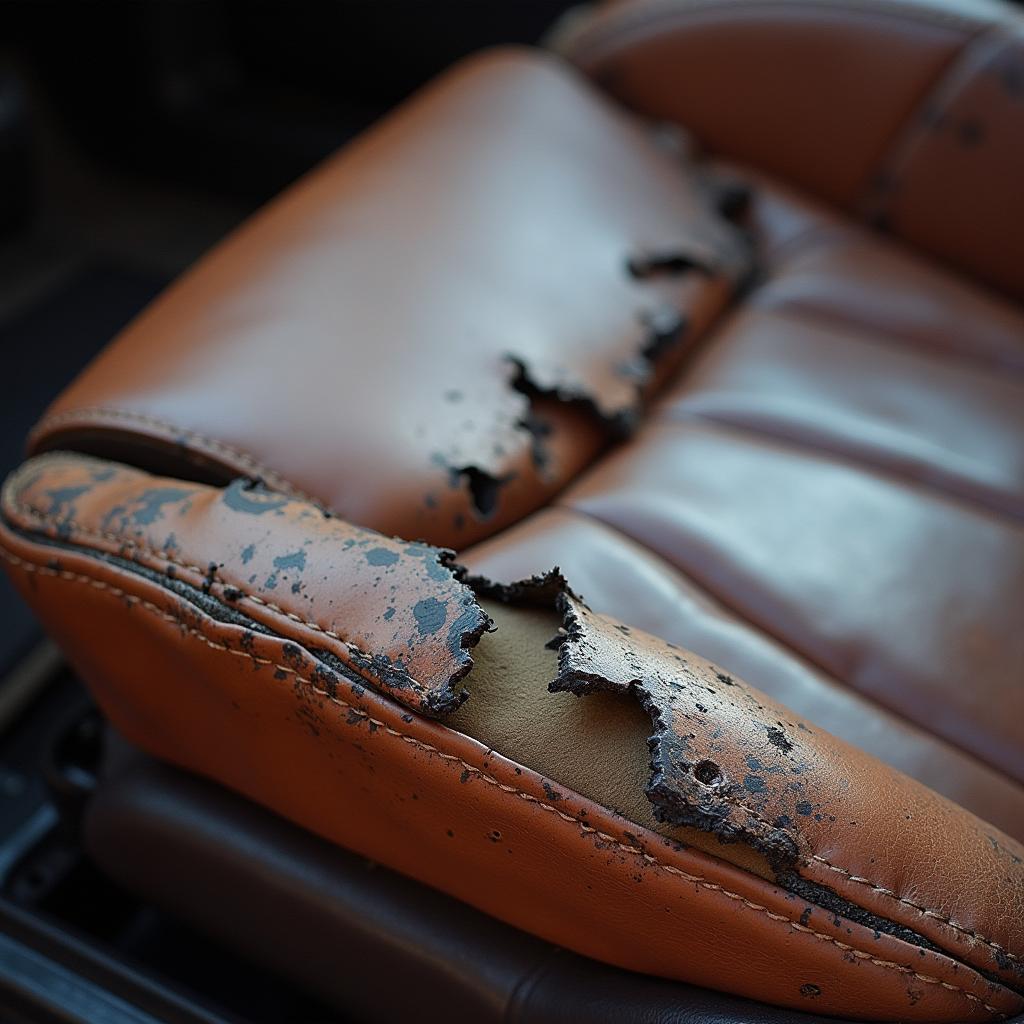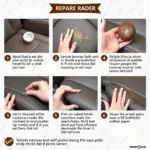A ripped or torn car seat can make your car look worn out and detract from the overall driving experience. While it might seem easier to ignore the damage, a ripped car seat can worsen over time and even pose a safety hazard. Luckily, repairing a ripped front seat is often achievable even for car owners with limited DIY experience. This comprehensive guide will provide you with a step-by-step approach to effectively fix that rip and restore your car’s interior.
Assessing the Damage and Choosing the Right Repair Method
Before diving into the repair process, it’s essential to assess the severity of the damage to your front seat. The appropriate repair method will depend on the type of material (leather, vinyl, cloth), the size of the rip, and the overall condition of the seat.
Types of Car Seat Materials:
- Leather: Known for its luxurious look and durability, leather requires specific repair kits and techniques to maintain its natural beauty.
- Vinyl: A more budget-friendly option, vinyl is relatively easier to repair and offers good resistance to wear and tear.
- Cloth: While comfortable and diverse in design, cloth seats can be more susceptible to stains and may require specialized cleaning methods.
Repair Options Based on Damage:
- Small Tears and Cracks: For minor damages, a liquid leather vinyl repair kit or a fabric repair patch can provide a quick and effective solution.
- Larger Rips and Tears: Larger damages often require a patch to bridge the gap. You can use materials like leather, vinyl patches, or even a strong fabric backing for added support.
- Extensive Damage: In cases of severe damage, seeking professional upholstery repair might be the most viable solution to restore the seat to its former glory.
DIY Repairing a Ripped Front Car Seat
For minor to moderate rips, a DIY approach can save you money and provide a sense of accomplishment. Here’s a step-by-step guide:
1. Gather Your Materials
- Cleaning solution
- Microfiber cloth
- Leather/vinyl repair kit (if applicable)
- Fabric repair patch (if applicable)
- Scissors
- Tweezers
- Leather/vinyl adhesive (if using a patch)
- Sub-patch material (for larger rips)
- Colorant and sealant (if needed)
2. Clean the Area Thoroughly
Before starting any repairs, clean the damaged area with a suitable cleaning solution and a microfiber cloth. This removes dirt, debris, and oils that could hinder the adhesion of repair materials. Allow the area to dry completely before moving on to the next step.
3. Repair the Rip
- For small tears and cracks: Apply the liquid leather/vinyl compound or fabric repair adhesive according to the product instructions. Use a spatula or a similar tool to evenly spread the compound and fill the tear. Let it dry completely.
- For larger rips and tears:
- Trim any frayed edges of the rip using sharp scissors.
- Cut a sub-patch material slightly larger than the rip. This will provide backing and support for the repair.
- Apply leather/vinyl adhesive to the backside of the rip and the sub-patch material.
- Carefully align and press the sub-patch material onto the underside of the rip.
- Apply adhesive to the top side of the sub-patch and carefully align and press the edges of the ripped material onto the sub-patch. Use tweezers to ensure a seamless bond.
4. Blending and Finishing Touches
- For leather and vinyl: Once the repair material is dry, use a color-matching compound to blend the repaired area with the surrounding material. You can find color-matching kits at most auto parts stores. Apply a leather/vinyl sealant to protect the repair and restore the material’s shine.
- For cloth: If you’ve used a fabric repair patch, ensure it blends well with the surrounding fabric. You can use fabric paint or markers to camouflage the repair if needed.
Professional Car Seat Repair: When to Call in the Experts
While DIY repairs can effectively address minor rips, there are instances where seeking professional upholstery repair is advisable:
- Extensive Damage: If the rip is extensive, involves complex stitching patterns, or affects the seat’s structural integrity, a professional upholsterer has the expertise and tools to handle the repair adequately.
- Airbag Deployment: Never attempt to repair a seat where the airbag has deployed. Tampering with the airbag system can be dangerous and should only be handled by certified technicians.
how to repair car seat stitch after airbag deployment
Preventing Future Rips and Tears
Preventing future damage to your car seats can save you time and money in the long run. Consider these preventative measures:
- Regular Cleaning: Regularly clean your car seats to prevent dirt and grime from weakening the material over time.
- Seat Covers: Investing in high-quality seat covers can protect your seats from spills, UV damage, and wear and tear.
- Careful Entry and Exit: Avoid sliding across the seats when entering or exiting the vehicle, as this can cause unnecessary friction and stress on the material.
Conclusion
A ripped front seat doesn’t have to be a permanent blemish on your car’s interior. By understanding the different repair methods and following the steps outlined in this guide, you can effectively tackle minor to moderate rips and restore your car seat’s appearance. However, for extensive damages, seeking professional car seat repair ensures a safe and long-lasting solution. Remember that regular maintenance and preventative measures can go a long way in keeping your car seats looking their best for years to come.
how much to repair a torn front seat of car
Frequently Asked Questions (FAQ)
- Can I use super glue to repair a ripped car seat?
- While superglue might seem like a quick fix, it’s not recommended for car seat repairs. Superglue can create a stiff and inflexible bond that can crack or break with regular use.
- How long does it take for a car seat repair to dry?
- The drying time for car seat repairs varies depending on the type of repair material used. Always refer to the product instructions for specific drying times. In general, allow at least 24 hours for the repair to fully cure before using the seat.
- Can I reupholster my car seats myself?
- Reupholstering car seats is a complex task that requires specialized skills and tools. It’s generally recommended to leave this job to professional upholsterers to ensure a high-quality and safe repair.
Need More Help?
Have more questions about how to repair ripped front seat in car or other car repair inquiries? We’re here to help! Contact our team of expert mechanics via WhatsApp: +1(641)206-8880, or email: [email protected] for 24/7 support and guidance.



